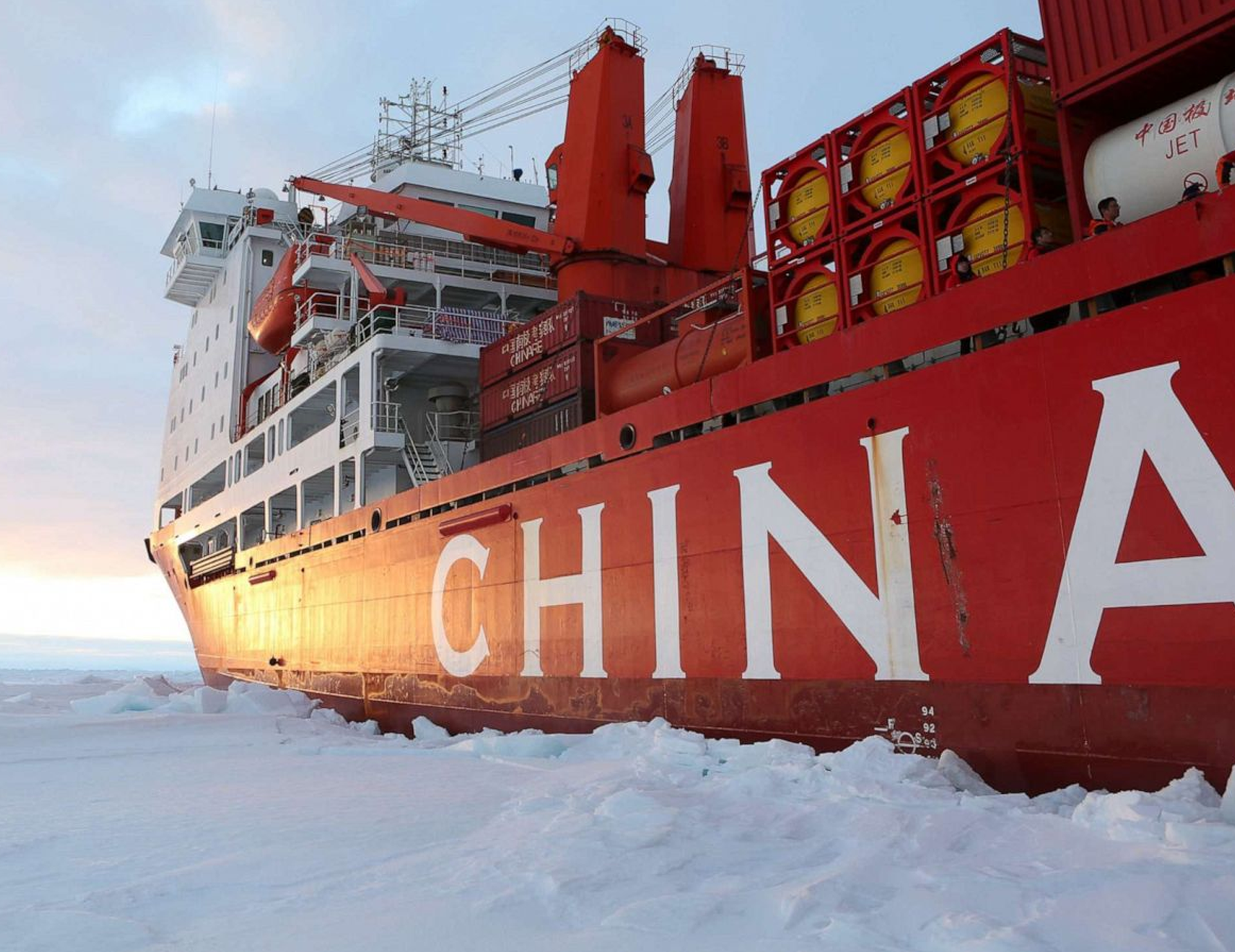China emerges as a rising power in the melting Arctic

In January 2018, China released its first white paper on the Arctic, titled “China’s Arctic Policy”. Sections in this document mention that “China is an important stakeholder in Arctic affairs. Geographically, China is a “Near-Arctic State,” one of the continental states that are closest to the Arctic Circle.” This articulation of its status faced criticism, particularly from the United States. On 6 May 2019, then US Secretary of State Michael Pompeo stated in a speech during a visit to Finland, “There are only Arctic states and non-Arctic states. No third category exists, and claiming otherwise entitles China to exactly nothing.” China, however, argues that the concept of “near-Arctic state” is not unique to its policy. For instance, the United Kingdom describes itself as “the Arctic’s nearest neighbour” in its “UK and the Arctic” policy paper. China’s white paper, while prioritising science and research, unequivocally asserts China’s rights in the region, stating: “States from outside the Arctic region do not have territorial sovereignty in the Arctic, but they do have rights in respect of scientific research, navigation, overflight, fishing, laying of submarine cables and pipelines in the high seas and other relevant sea areas in the Arctic Ocean, and rights to resource exploration and exploitation in the Area, pursuant to treaties such as UNCLOS and general international law.’ It goes further in clearly defining its role where it mentions “to participate in the governance of the Arctic, China will participate in regulating and managing the affairs and activities relating to the Arctic on the basis of rules and mechanisms.”
Resource interests and the Northern Sea route
As China’s economy keeps growing, Chinese manufacturers continue to demand an ever larger volume of the world’s natural resources and energy. With the Arctic region harboring both large quantities of oil and gas in addition to large organic and mineral resources, China is actively assessing the Arctic as a region to supply its growth. This is a development seen most profoundly in Greenland, but also in Iceland--both regions with concrete Chinese investments taking place today. Thus, one key aspect of China’s enhanced interest in the Arctic is China’s demand for natural resources and the potential supply of these commodities through the Northern Sea Route (NSR). As shipping through the NSR can be expected to increase gradually, China has a direct interest in following this development closely as a major potential destination.
Legitimizing Arctic engagement through climate rhetoric
China’s Arctic policy is a carefully calibrated strategy that balances its economic needs, security concerns, and ambition for global recognition and leadership. Despite being geographically distant from the Arctic Circle, China has declared itself a “near-Arctic state.” This claim, although met with skepticism by former US Secretary of State Mike Pompeo, serves a crucial purpose: it legitimizes China’s involvement in Arctic affairs. China argues that the cascading effects of climate change in the Arctic, particularly the accelerating melting of ice and the rising global sea levels, have far-reaching consequences. Even distant nations like China, where major coastal cities such as Shanghai and Tianjin face the threat of being potentially submerged, are impacted. By positioning itself as a responsible stakeholder with a vested interest in the region’s stability, sustainable development, and climate change mitigation, China justifies its expanding presence in Arctic affairs. Thus, it advocates for broader international participation and a more inclusive approach to Arctic governance, allowing it to engage in discussions without appearing as an outsider or opportunist. However, in doing so, China subtly challenges the existing governance framework, controlled mainly by the Arctic Council and its member states.
Scientific research with dual-use concerns
China is already normalising its activities in the Arctic, mainly through scientific research and exploration, although there is evidence that this research may have dual purposes. There are particular concerns about China’s Yellow River research station in Svalbard, a Norwegian archipelago high in the Arctic Ocean, 930km north of the mainland. US Congress members on the Chinese Communist Party Select Committee warned that some Chinese personnel working at the Yellow River were affiliated with a military company and had used data collected there to study missile-guidance technology. China also has a research laboratory in Kárhóll, northern Iceland, which, according to the committee, “appears to perform dual-use research” on Nato territory.
Strategic hesitations in Greenland
Chinese companies are generally more risk-averse than often assumed. Their evaluations of foreign investment environments place considerable weight on geopolitical risks, and in recent years, they have become increasingly attuned to the political sensitivities surrounding Greenland. Despite Greenland’s rhetoric about closer ties, Chinese investors are aware that Denmark retains the legal authority to block investments on national security grounds – and that the United States may respond forcefully if it perceives growing Chinese influence in Greenland. This heightened risk awareness has likely contributed to Chinese companies looking for opportunities elsewhere. For Greenland, while hopes of relying on Chinese investment may have waned in recent years due to shifting geopolitical realities and the United States reasserting its influence, trade with China remains important. China is a key export market for Greenlandic fish, a trade that benefits Greenland economically and poses no national security threat to Denmark or the United States. It is probably from this perspective we should interpret Greenland’s pursuit of closer ties with China at this point.
Militarized icebreaking capabilities
Sending three icebreakers into Arctic waters for the first time is “a clear signal” that Beijing is serious about pursuing its great power ambitions commercially, scientifically, diplomatically, and militarily in the polar regions, the co-author of a study of China’s strategic goals said in an interview with USNI News. Beijing cites climate and weather research as the primary justification for investing in icebreaker vessels, but these, too, could have military uses. It will allow China to be only the second country after Russia to send researchers to the deep polar seabeds for scientific exploration. In addition to human exploration, the Tan Suo San Hao will have aquatic drones for deep-sea research. State news agency Xinhua said: “It will expand China’s manned deep-sea capabilities from just deep-sea depths to all marine areas, effectively enhancing China’s [deep sea] capacity”. China is moving to expand its footprint and influence in the polar regions with shipping and research. Its push is also in keeping with Beijing’s goal of becoming a science superpower and boosting self-reliance amid rising tech and resource competitions with rivals, particularly the United States. In the summer of 2024, China’s Xue Long 2 icebreaker reportedly docked for the first time in Murmansk, the largest Russian port in the north of the Kola peninsula. Beijing currently has five polar icebreakers and is working on developing larger ships, including one 30,000-tonne nuclear-powered icebreaker, which is projected to cost a billion yuan (€134mn).
Joint projects with Russia
When talking about China's political and economic interests in the Arctic, it is impossible not to touch upon an important concept of state policy in this region - the "Polar Silk Road" (PSR), which is part of one of the key initiatives of the PRC - "Belt and Road". It was launched in July 2017, when Russia and China agreed on the joint development of the Arctic transport route. The PSR is an addition to the existing "Silk Road Economic Belt" and the "Maritime Silk Road of the 21st Century", in essence, it is a joint Russian-Chinese project to develop the Northern Sea Route (NSR) transport corridor and its integration into Chinese projects. It is considered by the Chinese authorities as a promising alternative to the existing land trade routes in Eurasia, as well as the traditional sea route through the Suez Canal, since the NSR offers a much shorter route between Asia and Europe (25-27 days, which is 2 times faster than the old routes). The main goal of the initiative is to increase the volume of cargo transportation along the NSR (initially it was planned to reach 80 million tons by 2024; the actual volume for 2024, according to Rosatom, was almost 37.9 million tons).
China is involved in a number of Russian Arctic projects, such as Yamal LNG and Arctic LNG 2. Yamal LNG is the largest liquefied natural gas (LNG) facility on the Yamal Peninsula, where China's CNPC and the Silk Road Fund hold a combined 29.9% stake. Arctic LNG 2 is another major Novatek LNG project, which includes the construction of three trains and export infrastructure. The project is currently underway, with the first train launched in July 2023, but further development has been slowed by Western sanctions. Chinese companies CNPC and CNOOC hold 20% of the shares in it.
Speaking about Western sanctions, it is also worth noting that they have had an impact on many aspects of Russian-Chinese cooperation. Firstly, a decrease in the role of Western countries in cooperation with Russia in the Arctic and a proportional increase in the role of China. If earlier Russia tried to involve non-Arctic countries in cooperation in the region as little as possible, then after restrictions on the supply of technology and equipment, as well as the suspension of interaction through the Arctic Council (7 of the 8 participants of which are part of the NATO alliance), it was forced to expand interaction with other actors, one of which is China, which firmly occupies a key place in the global economy.







